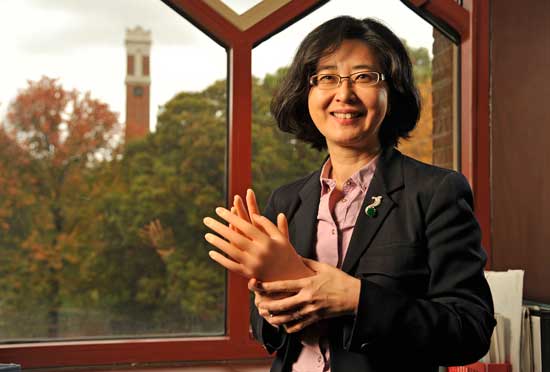Sohee Park’s research explores the impaired and enhanced abilities of the schizophrenic brain

The “rubber hand illusion” is not a new scientific method, but Sohee Park has used it to make some groundbreaking discoveries about schizophrenia.
RHI, which was discovered in 1998, is a laboratory exercise in which the subject’s hand, which is hidden from view, and a rubber hand, placed in front of the subject, are simultaneously stroked with a tactile tool such as a paint brush. In time, the sensation “tricks” the mind into identifying with the rubber hand as its own. In Park’s studies, she has observed that individuals with schizophrenia are more likely to disown their real hand, exhibiting what she sees as a weakened sense of body ownership.
“Healthy people get this illusion too, but weakly,” Park said. “Some don’t get it at all, and there is a wide range of individual differences in how people experience this illusion that is related to a personality trait called schizotypy, associated with psychosis-proneness.”
Her lab results not only revealed a person with schizophrenia’s greater ability to detach mentally from the body, but even produced the first case of a spontaneous out-of-body experience in the laboratory. This may lead to a greater understanding of the benefit of movement therapies such as yoga and dance for the 2.2 million people in the United States who suffer from this mental disorder.
Park’s path to her notable research at Vanderbilt began in Seoul, South Korea, where as a child she set her mind on becoming an anthropologist. Her sense of adventure and travel was influenced by her father, Kwon-Sang Park, a prominent Korean intellectual and writer who often brought back interesting objects from his world travels, and her uncle, an anthropology professor.
When she was 13, Park’s family was exiled by the military government because of her father’s writings, and they moved to England. “It was a drastic change to start all over in London, but it also opened up opportunities. At first, I didn’t know any English, but my teachers thought I was good at science and math so they pushed me in that direction. I loved physics anyway, so I decided to study it at university,” she said.
Park attended the University of Cambridge, where Newton, Maxwell, Rutherford and scores of other famous physicists have studied. In her last year, she sampled experimental psychology and loved it – particularly dealing with visual perception.
While studying for her doctorate in psychology at Harvard, she became interested in the question of how we integrate bits of information over time to form the perception of a coherent world and what happens when this integration fails. She found the answer under the guidance of Philip Holzman, a world expert on schizophrenia, when she worked with Holzman and Patricia Goldman-Rakic at Yale on a groundbreaking study to link eye-movement data from monkeys to that from humans to develop an animal model for schizophrenia.
Park and Holzman discovered that short-term (working) memory was severely impaired in schizophrenia. The realization that cognitive symptoms of this sort are central to schizophrenia has had a major impact on the field.
Following a five-year stint at Northwestern University, Park moved to Vanderbilt in 2000. “[rquote]Vanderbilt was building up a great brain imaging capability, and the vision scientists and neuroscientists were top leaders in their fields,” she said. “I saw the opportunity to start new and establish fruitful collaborations that I couldn’t accomplish anywhere else.”[/rquote]
In the last decade at Vanderbilt, Park’s work has continued to expand understanding of the role of cognition in schizophrenia. She has established collaborations with colleagues within her department, as well as with those in radiology, human development, political science and mechanical engineering. Last fall, she was named the Gertrude Conaway Vanderbilt Chair in Psychology.
“Sohee brings such enthusiasm and knowledge for the science and such compassion for the patients that it is a privilege to work with her,” collaborator Jeff Schall, the Ingram Professor of Neuroscience and director of the Center for Integrative and Cognitive Neuroscience, said.
Park’s recent work with RHI, as conducted by graduate assistant Katy Thakkar, paints a rich picture of schizophrenia as a complex combination of both impaired and enhanced abilities. Her research has found that schizophrenic individuals excel in visual imagery despite their severe visual memory impairments. Moreover, Park and her students have found that individuals with schizophrenia appear able to effortlessly put themselves in another person’s shoes. These results suggest that there may be some truth to the popular notion that there is a link between creativity and psychosis, she said.
One of Park’s newest initiatives is to explore the effectiveness of “brain training” to correct the cognitive deficits in survivors of childhood brain cancer. She will pursue this research with Bruce Compas, the Rhodes Hart Chair of Psychology. Eventually, Park and Compas hope to start a “brain training camp” that would include brain training exercise, music, dance and theater to improve the cognitive abilities and social functioning in these children.